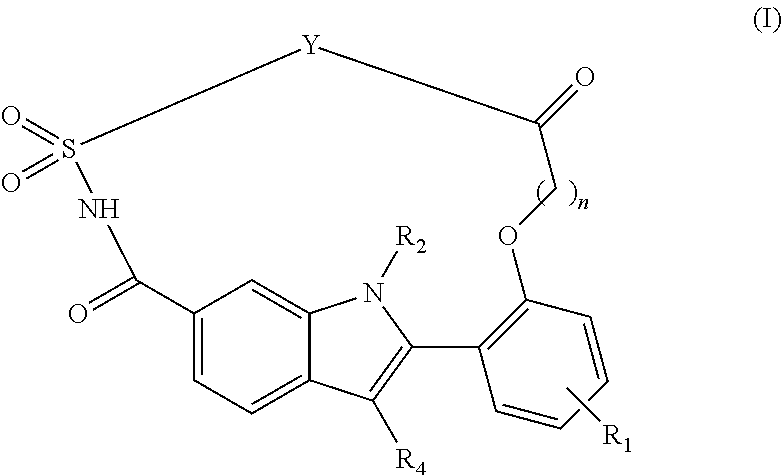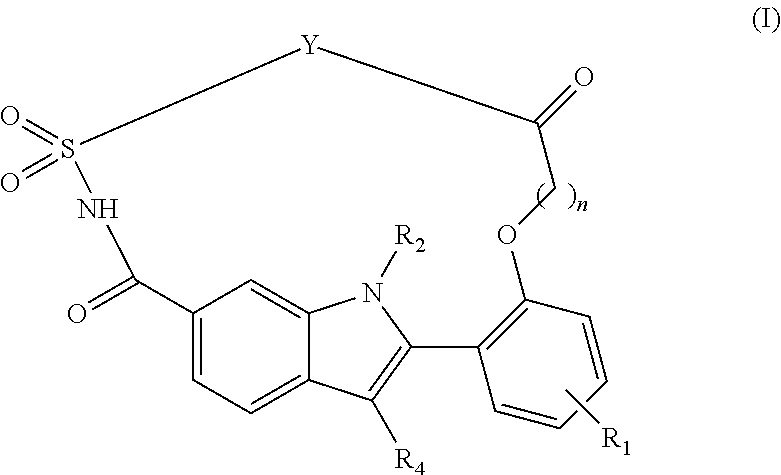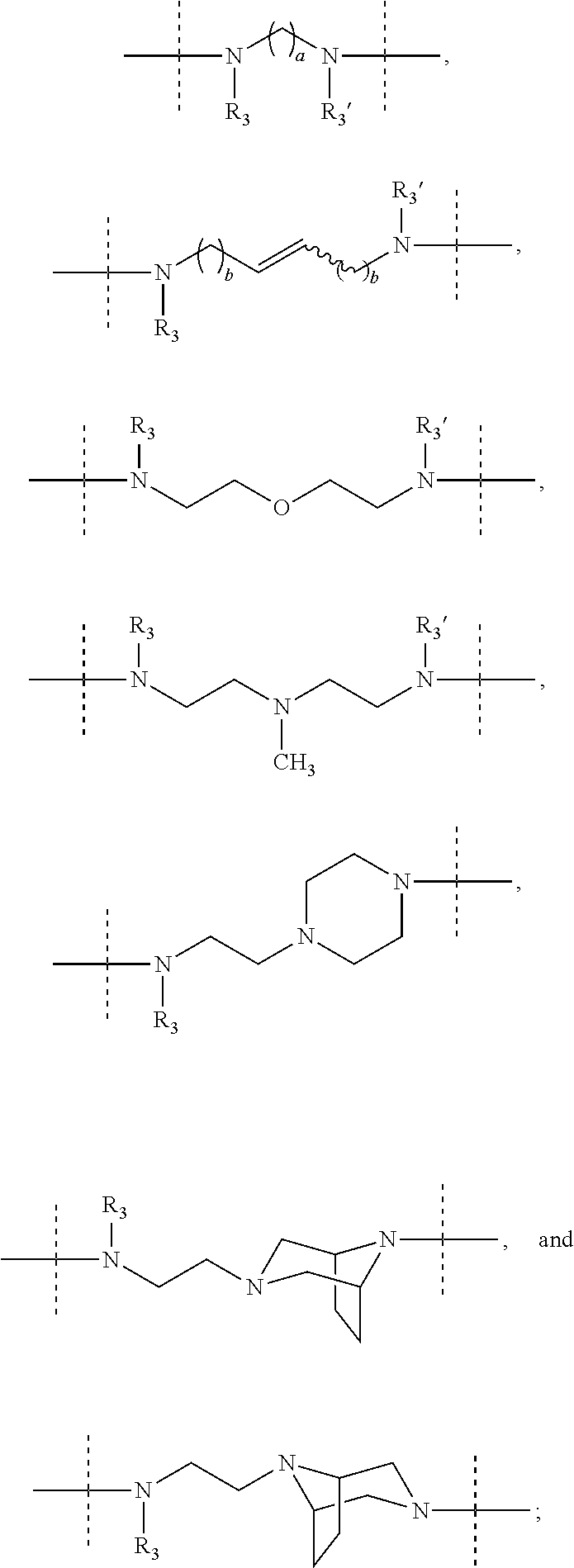Macrocyclic indole derivatives useful as hepatitis C virus inhibitors
a technology of indole derivatives and hepatitis c virus, which is applied in the field of macrocyclic indole derivatives, can solve the problems of persistent infection, high rate of chronic infection, and existing infections that will continue to present serious medical and economic burden, and achieve favorable mutant profile, lack of toxicity, and pharmacokinetic and metabolic profile favorable effects
- Summary
- Abstract
- Description
- Claims
- Application Information
AI Technical Summary
Benefits of technology
Problems solved by technology
Method used
Image
Examples
example 1
Synthesis of 25-cyclohexyl-4,10,19-trimethyl-5,6,9,10-tetrahydro-2H,8H-14,18:17,20-di(metheno)-1,7,11,4,10,12,19-benzodioxathiatetraazacyclodocosine-3,13 (4H,12H,19H)-dione 11,11-dioxide 10
[0168]
Step 1
[0169]
A solution of methyl 2-bromo-3-cyclohexyl-1H-indole-6-carboxylate (1, 6.14 g, 18.3 mmol), 2-(benzyloxy)phenylboronic acid (5.00 g, 21.9 mmol) and potassium carbonate (5.80 g, 42 mmol) in 450 mL of 1,2-dimethoxyethane / water (4:1) was thoroughly flushed with argon. Then trans-BIS(triphenylphosphine)palladium(II) chloride (0.641 g, 0.91 mmol) was added and the reaction was heated at 70° C. under argon for 12 h. The reaction mixture was cooled to room temperature, diluted with water and extracted with ethylacetate (AcOEt). Combined organic layers were washed with a saturated solution of NaHCO3 and brine, dried over anhydrous Na2SO4 and filtered. The filtered solution was concentrated under vacuum to give methyl 2-[2-(benzyloxy)phenyl]-3-cyclohexyl-1H-indole-6-carboxylate 2: m / z=440 (...
example 2
Synthesis of 24-cyclohexyl-4,9,18-trimethyl-4,5,6,7,8,9-hexahydro-13,17:16,19-di(metheno)-1,10,4,9,11,18-benzoxathiatetraazacyclohenicosine-3,12(2H,11H,18H)-dione 10,10-dioxide 15
[0186]
Step 1.
[0187]
[0188]Compound 11 was synthesized in 88% yield from intermediate 5 and N,N′-dimethylbutylene diamine following the procedure reported for the synthesis of methyl 3-cyclohexyl-1-methyl-2-[2-(2-{methyl[4-(methylamino)butyl]amino}-2-oxoethoxy)phenyl]-1H-indole-6-carboxylate 6: m / z=520 (M+H)+.
Step 2.
[0189]
[0190]Methyl 3-cyclohexyl-1-methyl-2-{2-[2-(methyl {4-[methyl(sulfamoyl)amino]butyl}amino)-2-oxoethoxy]phenyl}-1H-indole-6-carboxylate 12 was synthesized in 68% yield from intermediate 11 following the procedure reported for the synthesis of intermediate 7: m / z=599 (M+H)+.
Step 3.
[0191]
[0192]3-cyclohexyl-1-methyl-2-{2-[2-(methyl {4-[methyl(sulfamoyl)amino]butyl}amino)-2-oxoethoxy]phenyl}-1H-indole-6-carboxylic acid 13 was synthesized in 78% yield from intermediate 12 following the procedure r...
example 3
Synthesis of 25-cyclohexyl-10,19-dimethyl-5,6,7,8,9,10-hexahydro-2H-14,18:17,20-di(metheno)-1,11,4,10,12,19-benzoxathiatetraazacyclodocosine-3,13(4H,12H,19H)-dione 11,11-dioxide 21
[0197]
Step 1
[0198]
[0199]A solution of 2-(2-(3-cyclohexyl-6-(methoxycarbonyl)-1-methyl-1H-indol-2-yl)phenoxy)acetic acid 5 (1 g, 2.373 mmol), N-(5-aminopentyl)-N-methyl-2-nitrobenzenesulfonamide 16 (0.715 g, 1 eq), diisopropylethylamine (0.92 g, 3 eq) and HATU (1.353 g, 1.5 eq) in dry THF (25 mL) was stirred at room temperature overnight. Then, the reaction mixture was successively poured in water, extracted with dichloromethane, dried over MgSO4 and concentrated. The resulting residue was purified by flash chromatography using a gradient of methanol in DCM as eluent, to give 1.27 g (76% yield) of the title product methyl 3-cyclohexyl-1-methyl-2-(2-{2-[(5-{methyl[(2-nitrophenyl)sulfonyl]amino}pentyl)amino]-2-oxoethoxy}phenyl)-1H-indole-6-carboxylate 17; m / z=705 (M+H)+.
Step 2
[0200]
[0201]To a solution of meth...
PUM
| Property | Measurement | Unit |
|---|---|---|
| temperature | aaaaa | aaaaa |
| temperature | aaaaa | aaaaa |
| temperature | aaaaa | aaaaa |
Abstract
Description
Claims
Application Information
 Login to View More
Login to View More - R&D
- Intellectual Property
- Life Sciences
- Materials
- Tech Scout
- Unparalleled Data Quality
- Higher Quality Content
- 60% Fewer Hallucinations
Browse by: Latest US Patents, China's latest patents, Technical Efficacy Thesaurus, Application Domain, Technology Topic, Popular Technical Reports.
© 2025 PatSnap. All rights reserved.Legal|Privacy policy|Modern Slavery Act Transparency Statement|Sitemap|About US| Contact US: help@patsnap.com



